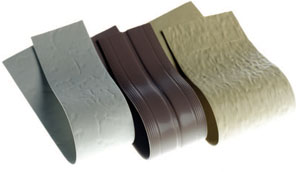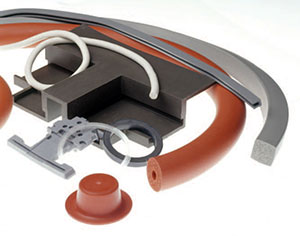Specifying Silicone Sealants: Providing Weather Sealing and Flexibility Between Building Components
Renovation / Restoration Applications
• Restoration of existing joints. To restore joints containing
failed polyurethane or other organic sealants, complete
removal of the failed sealant is usually recommended. This
typically means grinding the joint surfaces down to the original substrate to prepare for the new field applied silicone sealant. Before installation, however, it is first recommended that field adhesion tests be performed on representative areas of the existing substrates to determine whether a new silicone sealant will adhere properly to the existing material and whether or not a primer
is required.
• Existing window applications. Another common restoration application is the use of new seals between the window frame and glass. The use of fillet beads and bridge joints should be used at all window joinery to prevent water from entering the window system. Bridge joints can be produced with wet sealant or
precured sealant.
 |
Pre-formed silicone seals, used for both new and remedial construction applications. |
 |
| Custom-designed, pre-formed silicone seals and gaskets, used for both new and remedial construction applications. |
• Precured silicone sealant applications. Precured and pre-formed silicone sealants were introduced in the early 1990s as an innovative way to restore failed polyurethane sealant joints. These products have found acceptance in joints where the original failed polyurethane sealant has reverted or is very difficult or costly to remove and can be used in difficult-to-seal joints such as splice joints in window systems or on roof parapet caps. These products are applied on the face of the joint adjacent to the existing sealant joint hence the existing sealant does not need to be removed under normal circumstances. Precured silicone sealants are available in a variety of standard and custom colors, in widths from 1 to 12 inches, textured for substrates such as EIFS, and notched to allow the strips to conform easily around corners. Recently, custom extrusions and molded precured silicone sealant designs have been introduced. These materials can be formed into molded boots or extrusions, then adhered with silicone sealants. These products have found acceptance in new curtainwall designs as well as restoration applications.
• EIFS restoration applications. EIFS is a building material that offers some unique challenges to proper sealant design and restoration. EIFS is a soft substrate; as a result, selection of the right sealant is critical to the material's performance. A high-modulus sealant can cause the EIFS coating to delaminate.
A sealant that is low modulus and stays low modulus when cold is much less likely to cause this problem. When an EIFS joint fails, it is often difficult to replace the failed sealant since EIFS coatings and mesh can be easily damaged if a grinder is used for removal. Instead, a solution that is gaining broad acceptance is the use of a precured silicone sealant bridge joint to span the failed joint. Then, the entire EIFS wall, including the precured silicone sealant, can then be coated with a silicone elastomeric coating to provide a cost-effective watertight wall. When used together, these products offer a unique solution to many of the problems associated with EIFS. Silicone offers long-term watertight performance, and the coating is highly permeable, allowing trapped moisture to escape.
Part 3 - Installation of Silicone Sealants
New Construction for Weatherseal Joints
Proper installation of sealant requires that certain steps be followed which should be articulated in the specification.
• First, the substrate materials must be clean, dry and frost-free. Depending on the substrate, this may require abrasion or solvent cleaning.
• Priming is then done for certain sealant/substrate combinations.
• After cleaning and priming, a backer material is installed. The backer rod allows the sealant to be installed and tooled properly and provides a proper joint shape. The backer rod should be sized at least 25% larger than the joint.
• The sealant is then installed and tooled. The sealant should completely fill the joint. Tooling ensures that the joint is filled to the proper joint shape and that the sealant wets out the sides of the joint.
• Finally, field adhesion testing should be conducted at the start of the job and throughout the project to verify sealant adhesion and to track the workmanship of the contractor. Final testing is performed on the sealant one or two weeks after it has been installed all with the results documented in a quality assurance log. Note that each sealant has different pass/fail criteria. Some sealants require a certain percent elongation, while others require cohesive failure of the sealant. Each manufacturer should publish its pass/fail criteria.
Restoration / Renovation
Similar to new construction installation, the proper sequence of steps must be followed:
For field-installed "wet joints" of new silicone sealant to replace old sealant:
• Grind off and remove the old sealant.
• Follow the steps above for new construction installation.
• Install a defined number of "test joints" first and assess them before starting the full restoration project.
For installation of pre-cured sealants where the existing joint seal is to remain:
• First, the substrate is cleaned as the manufacturer recommends.
• Next, a silicone sealant is applied in a uniform bead adjacent to the joint.
• Then, the strip of precured silicone sealant is pressed into the wet sealant. The contact areas should be at least 3/8-inch once the wet sealant is compressed.
• Once the sealant is cured, it chemically bonds to the substrate as well as to the precured silicone sealant strip.
• If appropriate, clean the entire surface and install a new
elastomeric silicone coating over the existing material and the restored joint.
In the end, it's all about the details and the skill of the contractors. Pay attention to both and you've gone a long way toward a truly quality installation that will help protect and preserve buildings for many years to come.
Additional Specification Details
Testing Standards for Sealants
Sealants testing has become comprehensive and well documented. Listed below are some of the most referenced and relevant standards for sealants. For copies of these standards, go to the ASTM website: www.astm.org.
• ASTM C-719 Movement Capability Test Method
• ASTM C-794 Adhesion in Peel Test Method
• ASTM C-920 Standard Sealant Specification
• ASTM C-1184 Structural Glazing Specification
• ASTM C-1193 Guide for Use of Sealants
• ASTM C-1248 Stain Test Method
• ASTM C-1299 Guide for Selection of Sealants
• ASTM C-1401 Guide to Structural Glazing
• ASTM C-1472 Guide for Calculating Joint Movement
• ASTM C-1481 Guide to Use of Sealants with EIFS
In addition to ASTM testing, the trade association that oversees sealants is the Sealant Waterproofing & Restoration Institute (SWRI). (www.swrionline.org). According to their website, "SWR Institute is an international trade association that represents the commercial sealant, waterproofing and restoration construction industry. Our members are some of the most experienced and qualified contractors, manufacturers and design professionals in the industry. Through our educational programs and publications, our members promote industry-wide standards of application and products. The members of SWR Institute are very active and are constantly striving to advance our industry and the quality of work that is performed." In specifying sealant and coating products the SWRI acknowledges that "manufacturer's product performances claims can, at times, be either confusing, incomplete, or misleading - especially when trying to compare different sealant and wall coating products." The SWR Institute has therefore implemented a "Validation Program" as a means to help alleviate the confusion. This requires that manufacturers independently submit material to be independently tested to determine "whether they perform as stated by the manufacturer and to industry standards. Once a product passes the validation process, SWR Institute then grants its Validation Seal and provides the test data in a clear and concise manner." Hence calling for products that carry the SWR Institute Seal of Validation is entirely appropriate in silicone sealant specification writing.
Sealant Schedule
As with many specification sections, a summary schedule that identifies where to use different types of relevant products helps contractors and designers quickly see the choices made. Using a Sealant schedule to help illuminate a specification can be a useful tool for communicating and summarizing the types of products that are being called for on a particular project. The information below can be useful in creating such a schedule:
General Purpose Silicone Sealant for Use as a Weather Seal
• Ultra-low-modulus expansion (+100/-50 percent) higher joint movement sealant − particularly good for porous substrates
• Medium modulus, (±50 percent) general weatherseal sealant
• Higher modulus weatherproofing Sealant (±25 percent) − for low joint movement or non-critical locations
• Concrete Sealant (±50 percent) - primerless adhesion to most porous substrates , particularly good for concrete
Sensitive Substrate Weather Seal
• Building Sealant specifically formulated to avoid staining of substrate materials per ASTM C-1248 Stain Test Method
Parking Structure Sealants
• NS - Non-sag sealant for horizontal and vertical control and expansion joints
• SL - Self-leveling sealant for horizontal control and expansion joints
• FC - Fast curing, self-leveling, two- component sealant for dynamic expansion joints
Pre-cured Silicone Seal
• Silicone material product pre-formed to meet specification and design requirements
Supporting Information
In preparing sealant schedules and even specifications, it is not uncommon for architects to rely on other sources. In addition to ASTM, one of the most common resources is AIA Masterspec prepared by ARCOM. The relevant section 079200 has been updated
in recent years to include all of the latest classes of sealants and is available online at www.masterspec.com. It is also common for architects to check in with building product manufacturers and specialists to assist with specification details.









